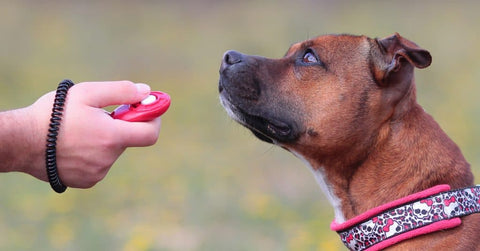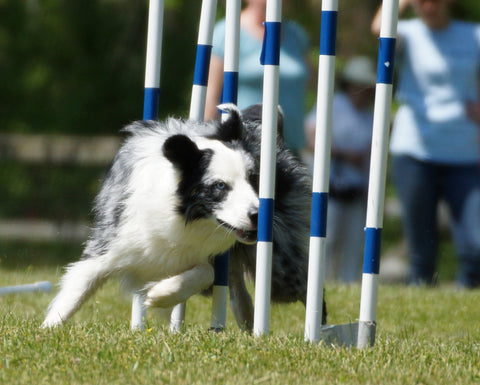Introduction
Begin by explaining what agility training is and why it's beneficial for dogs. Highlight how agility training involves guiding dogs through an obstacle course, improving their physical fitness, mental stimulation, and strengthening the bond between the dog and the owner. Emphasize the fun and engaging nature of agility training for both dogs and their owners.
Benefits of Agility Training
1. Physical Exercise
- Improved Fitness: Explain how agility training provides a full-body workout, enhancing the dog's overall fitness, strength, and stamina.
- Weight Management: Discuss how regular agility training helps maintain a healthy weight, reducing the risk of obesity-related health issues.
2. Mental Stimulation
- Cognitive Skills: Highlight how navigating obstacles enhances a dog's problem-solving skills and mental sharpness.
- Reduced Boredom: Explain how agility training prevents boredom and associated behavioral problems by providing a challenging and engaging activity.
3. Bonding and Socialization
- Strengthened Bond: Discuss how working together in agility training strengthens the bond between the dog and the owner.
- Social Skills: Mention how agility training classes offer opportunities for dogs to socialize with other dogs and people.

Understanding the Basics of Agility Training
1. Essential Equipment
- Obstacles Overview: Provide an overview of common agility obstacles such as jumps, tunnels, weave poles, and A-frames.
- DIY Options: Suggest DIY options for building agility equipment at home using common household items.
2. Safety Considerations
- Health Check: Recommend getting a health check from a veterinarian before starting agility training to ensure the dog is physically fit.
- Surface Safety: Discuss the importance of training on safe surfaces to prevent injuries, such as grass or padded flooring.
Preparing for Agility Training
1. Basic Obedience Skills
- Foundation Commands: Emphasize the importance of basic obedience skills like sit, stay, come, and heel as a foundation for agility training.
- Focus and Attention: Discuss exercises to improve the dog's focus and attention, which are crucial for successful agility training.
2. Introducing Equipment
- Gradual Introduction: Explain how to gradually introduce the dog to each piece of equipment, starting with simpler obstacles and progressing to more complex ones.
- Positive Reinforcement: Highlight the importance of using positive reinforcement, such as treats and praise, to encourage the dog.
Step-by-Step Guide to Getting Started
1. Basic Jump Training
- Setting Up: Describe how to set up a simple jump using adjustable bars or poles.
- Training Steps: Provide a step-by-step guide to teaching the dog to jump over the bar, starting with a low height and gradually increasing it.
2. Tunnel Training
- Introducing the Tunnel: Explain how to introduce the dog to a tunnel, starting with a short, straight tunnel and gradually increasing the length.
- Encouraging Entry: Provide tips on encouraging the dog to enter and run through the tunnel, using treats and toys as incentives.
3. Weave Poles Training
- Setting Up: Discuss how to set up weave poles in a straight line.
- Training Steps: Provide detailed steps on teaching the dog to weave through the poles, starting with wider spacing and gradually narrowing it.
4. A-Frame and Contact Obstacles
- Introducing Contact Obstacles: Explain the importance of contact obstacles like the A-frame and how to introduce them safely.
- Teaching Contacts: Discuss techniques for teaching the dog to hit the contact zones, using target training and positive reinforcement.

Common Challenges and Solutions
1. Fear and Hesitation
- Building Confidence: Provide tips on building the dog’s confidence with each obstacle, starting with lower heights and simpler tasks.
- Positive Reinforcement: Emphasize the continuous use of positive reinforcement to encourage the dog and reduce fear.
2. Distractions
- Focus Training: Discuss strategies for improving the dog’s focus during training, such as minimizing distractions and gradually introducing them.
- Consistency: Highlight the importance of consistent training sessions to reinforce focus and obedience.
3. Physical Limitations
- Modifying Obstacles: Explain how to modify obstacles for dogs with physical limitations or those recovering from injuries.
- Consulting a Veterinarian: Recommend consulting a veterinarian for advice on safe training practices for dogs with specific health concerns.
Joining an Agility Training Class
1. Finding a Class
- Local Clubs and Trainers: Suggest searching for local agility clubs or professional trainers who offer classes for beginners.
- Online Resources: Mention online resources and forums where owners can find recommendations for agility classes.
2. Benefits of Group Classes
- Socialization: Highlight the socialization benefits of group classes for both dogs and owners.
- Expert Guidance: Discuss the advantages of receiving expert guidance and feedback from experienced trainers.

Competing in Agility Trials
1. Understanding Agility Competitions
- Competition Levels: Explain the different levels of agility competitions, from beginner to advanced.
- Trial Formats: Provide an overview of the various trial formats and what to expect during a competition.
2. Preparing for Competition
- Training Consistency: Emphasize the importance of consistent training to prepare for competition.
- Trial Practice: Suggest attending practice trials or fun matches to get the dog accustomed to the competition environment.
Case Studies and Testimonials
1. Real-Life Experiences
- Owner Testimonials: Share testimonials from dog owners who have successfully started agility training with their dogs.
- Positive Outcomes: Highlight the positive outcomes and benefits observed, such as improved fitness, behavior, and bond.
2. Case Studies
- Success Stories: Provide detailed case studies of dogs with specific training challenges that were overcome through agility training.
- Before and After: Include before and after stories to illustrate the improvements in the dog's agility skills and confidence.
Conclusion
Summarize the key points about getting started with agility training for dogs, emphasizing the importance of starting with basic obedience, gradually introducing equipment, and maintaining a consistent training routine. Highlight the long-term benefits of agility training for the dog’s physical and mental health, as well as the strengthened bond between the dog and owner.
Call to Action
Encourage readers to start agility training with their dogs and to share their experiences or additional tips in the comments section. Invite them to subscribe to the blog for more dog training tips and advice.
